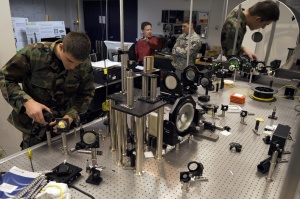Jan 26 2009
A research associate at the U.S. Air Force Academy's Laser and Optics Research Center here is developing a new capability that will allow satellites to be seen and see clearer.
 U.S. Air Force Academy Cadet Will Holmes conducts holographic adaptics optics research with U.S. Military Academy Cadet Richard Carter and Dr. Geoff Andersen Jan. 22 at the Academy in Colorado. Dr. Andersen is a research associate, teaches cadets and conducts experiments at the Laser and Optics Research Center. Cadet Carter is a junior in a exchange unit from West Point and Cadet Holmes is a senior at the Academy. (U.S. Air Force photo/Staff Sgt. Desiree N. Palacios)
U.S. Air Force Academy Cadet Will Holmes conducts holographic adaptics optics research with U.S. Military Academy Cadet Richard Carter and Dr. Geoff Andersen Jan. 22 at the Academy in Colorado. Dr. Andersen is a research associate, teaches cadets and conducts experiments at the Laser and Optics Research Center. Cadet Carter is a junior in a exchange unit from West Point and Cadet Holmes is a senior at the Academy. (U.S. Air Force photo/Staff Sgt. Desiree N. Palacios)
Dr. Geoff Andersen developed the process, called holographic adaptic optics, that uses sensors and lenses that can correct for disturbances in the atmosphere.
Atmospheric disturbances can interfere with ground-based optical telescope's abilities to clearly see satellites orbiting the earth.
"Stars don't twinkle," Dr. Andersen said. "This is just the effect of atmospheric interference on our ability to see into space."
Dr. Andersen's process uses adaptive technology to compensate for this interference.
"Think of it like wearing a pair of glasses," he said. "When someone has poor eyesight, the prescription compensates for this and makes his or her eyesight better. This process is similar. It uses adaptive optics so telescopes can see into space better."
This is important to the Air Force because it will allow the service to better see its satellites. For instance, if a satellite stops communicating with personnel on the ground, they can view it on a telescope to determine what caused it to go off the grid.
"Naturally, the clearer you can see the satellite, the easier it will be to diagnose the problem," Dr. Andersen said.
Air Force officials have been using various forms of technology to view its satellites for several decades, but the equipment used to perform this is expensive, computer intensive and large.
"The computer itself is as large as a room," Dr. Andersen said.
This new system, which Dr. Andersen has the patent for, uses holograms and is condensed into a device the size of a standard DVD player. This makes it cheaper and opens the door to new possibilities.
"We could place one of these devices on a satellite and then the satellite would be able to see down to earth with a crystal image," Dr. Andersen said.
Devices could also be placed on unmanned aircraft systems, allowing them to produce a clearer image for combatant commanders. UAS' are perfect candidates for this technology due to their type and height of flight, Dr. Andersen said.
"UAS' produce their own turbulence when flying and they tend to fly in the general area where atmospheric interference is high," he said. "This new technology would eliminate these problems and allow the UAS to produce a high-quality, sharp image."
The adaptive optics technology goes beyond having only military applications. It also has uses within the medical arena -- especially that of laser eye surgery.
"This technology will make eye surgery more precise and specialized," Dr. Andersen said.
Capabilities aside, Dr. Andersen said he is proud to be instrumental in the creation of this holographic technology. He's also proud of the cadets he teaches and who help him on a daily basis.
"They get hands on to help find solutions using research," he said.
The students are happy to help, knowing that the work they are doing today could possibly shape the future of imagery technology.
"It makes it really worth it knowing there's a real-world application for what we're doing here in the laboratory," said Cadet Will Holmes, a senior at the Academy. "And it's great getting to work with Dr. Andersen."